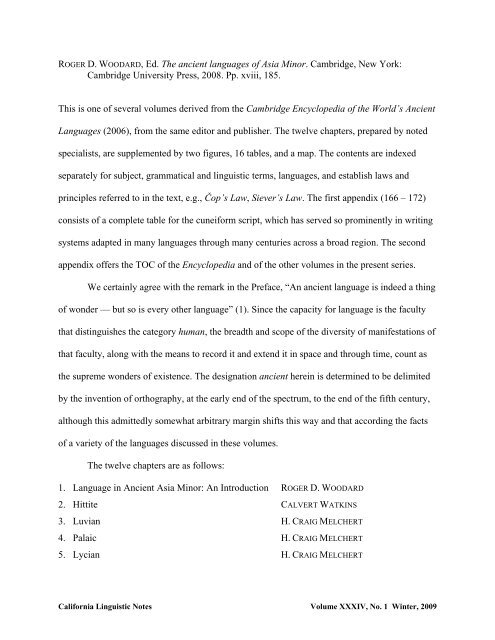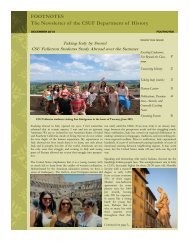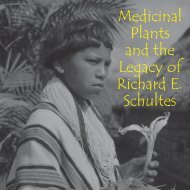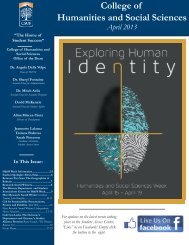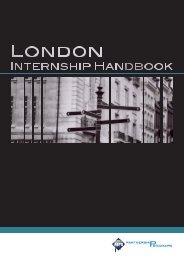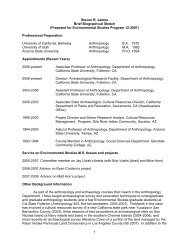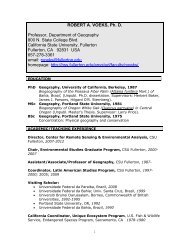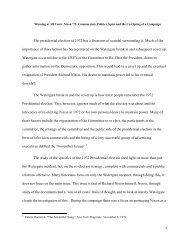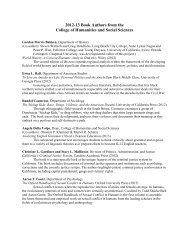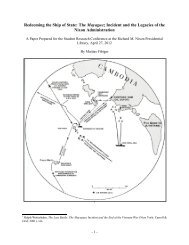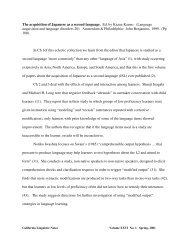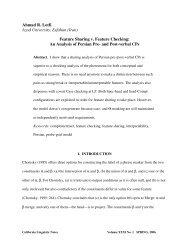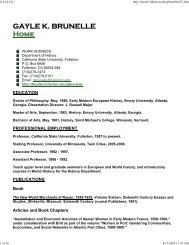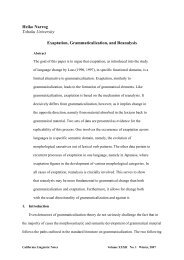ROGER D. WOODARD, Ed. The ancient languages of Asia Minor ...
ROGER D. WOODARD, Ed. The ancient languages of Asia Minor ...
ROGER D. WOODARD, Ed. The ancient languages of Asia Minor ...
You also want an ePaper? Increase the reach of your titles
YUMPU automatically turns print PDFs into web optimized ePapers that Google loves.
<strong>ROGER</strong> D. <strong>WOODARD</strong>, <strong>Ed</strong>. <strong>The</strong> <strong>ancient</strong> <strong>languages</strong> <strong>of</strong> <strong>Asia</strong> <strong>Minor</strong>. Cambridge, New York:<br />
Cambridge University Press, 2008. Pp. xviii, 185.<br />
This is one <strong>of</strong> several volumes derived from the Cambridge Encyclopedia <strong>of</strong> the World’s Ancient<br />
Languages (2006), from the same editor and publisher. <strong>The</strong> twelve chapters, prepared by noted<br />
specialists, are supplemented by two figures, 16 tables, and a map. <strong>The</strong> contents are indexed<br />
separately for subject, grammatical and linguistic terms, <strong>languages</strong>, and establish laws and<br />
principles referred to in the text, e.g., Čop’s Law, Siever’s Law. <strong>The</strong> first appendix (166 – 172)<br />
consists <strong>of</strong> a complete table for the cuneiform script, which has served so prominently in writing<br />
systems adapted in many <strong>languages</strong> through many centuries across a broad region. <strong>The</strong> second<br />
appendix <strong>of</strong>fers the TOC <strong>of</strong> the Encyclopedia and <strong>of</strong> the other volumes in the present series.<br />
We certainly agree with the remark in the Preface, “An <strong>ancient</strong> language is indeed a thing<br />
<strong>of</strong> wonder — but so is every other language” (1). Since the capacity for language is the faculty<br />
that distinguishes the category human, the breadth and scope <strong>of</strong> the diversity <strong>of</strong> manifestations <strong>of</strong><br />
that faculty, along with the means to record it and extend it in space and through time, count as<br />
the supreme wonders <strong>of</strong> existence. <strong>The</strong> designation <strong>ancient</strong> herein is determined to be delimited<br />
by the invention <strong>of</strong> orthography, at the early end <strong>of</strong> the spectrum, to the end <strong>of</strong> the fifth century,<br />
although this admittedly somewhat arbitrary margin shifts this way and that according the facts<br />
<strong>of</strong> a variety <strong>of</strong> the <strong>languages</strong> discussed in these volumes.<br />
<strong>The</strong> twelve chapters are as follows:<br />
1. Language in Ancient <strong>Asia</strong> <strong>Minor</strong>: An Introduction<br />
2. Hittite<br />
3. Luvian<br />
4. Palaic<br />
5. Lycian<br />
<strong>ROGER</strong> D. <strong>WOODARD</strong><br />
CALVERT WATKINS<br />
H. CRAIG MELCHERT<br />
H. CRAIG MELCHERT<br />
H. CRAIG MELCHERT<br />
California Linguistic Notes Volume XXXIV, No. 1 Winter, 2009
6. Lydian<br />
7. Carian<br />
8. Phrygian<br />
9. Hurrian<br />
10. Urartian<br />
11. Classical Armenian<br />
12. Early Georgian<br />
H. CRAIG MELCHERT<br />
H. CRAIG MELCHERT<br />
CLAUDE BRIXHE<br />
GERNOT WILHELM<br />
GERNOT WILHELM<br />
JAMES P. T. CLACKSON<br />
KEVIN TUITE<br />
With the exception <strong>of</strong> Hurrian and Urartian (Chs. 9, 10), which bear features observed in<br />
more than one family but have not been definitively associated with an established language<br />
family, and Georgian, a Caucasian tongue, the <strong>languages</strong> reported on in these articles are <strong>of</strong> the<br />
Indo-European taxon, which reflects the degree and extent <strong>of</strong> prominence <strong>of</strong> societies who spoke<br />
IE <strong>languages</strong> during the time period recorded.<br />
<strong>The</strong> articles in this volume discuss the expected and necessary background and history <strong>of</strong><br />
the <strong>languages</strong> and their speakers, the orthographic records on which study is based, and a<br />
summary <strong>of</strong> the history <strong>of</strong> scholarship on the <strong>languages</strong>. Of particular importance is the attention<br />
paid to the orthographic systems employed for these <strong>languages</strong>, on which we depend for all <strong>of</strong><br />
our knowledge <strong>of</strong> them. While it is theoretically possible that any writing system can record any<br />
language, the inevitable and substantial inconveniences produced when a poor fit <strong>of</strong> the system<br />
to the language obtains, as among others in the case <strong>of</strong> using Hanzi ‘Chinese characters’ for<br />
writing Korean, leads to revision or adoption <strong>of</strong> a different system. Thus early Western Semitic<br />
writing became alphabetic, and in the hands <strong>of</strong> the Greeks and later the Romans was arranged to<br />
represent vowels. Such changes are made to accommodate the realities <strong>of</strong> the language — its<br />
phonetics, its morphology, and its typology. Thus, when looking backward at an extinct<br />
language through the inverted telescope <strong>of</strong> its orthographic record, we are guided by the nature<br />
<strong>of</strong> that system in our discovery.<br />
California Linguistic Notes Volume XXXIV, No. 1 Winter, 2009<br />
2
<strong>The</strong> contents <strong>of</strong> these articles exceed the sets <strong>of</strong> facts expected in a language<br />
encyclopedia, and provide comprehensive information about the aforementioned aspects <strong>of</strong> study,<br />
along with features <strong>of</strong> the phonology, morphology, syntax and lexicon <strong>of</strong> the <strong>languages</strong>. Any<br />
student <strong>of</strong> language, anthropology, or any discipline that crosses into the history <strong>of</strong> language and<br />
culture in the region will enrich their knowledge by reference to this volume.<br />
Robert D. Angus<br />
California State University, Fullerton<br />
California Linguistic Notes Volume XXXIV, No. 1 Winter, 2009<br />
3


